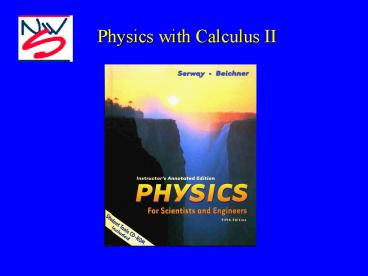Physics with Calculus II PowerPoint PPT Presentation
Title: Physics with Calculus II
1
Physics with Calculus II
2
(No Transcript)
3
Where weve been
- Mechanics
- The Electric Field
- Electric Potential (V)
- DC Circuits
- Magnetics
- ac circuits
- Harmonic Motion
- Waves
4
Ch 17 Introduction
Audible compressional or longitudinal waves to
which the human ear is sensitive range from 20 Hz
to 20,000 Hz. Waves below 20 Hz are called
infrasonic and those above 20,000 Hz are called
ultrasonic.
5
Where were going
Ch 17 Sound Waves (17.1) Speed of Sound
Waves (17.2) Periodic Sound Waves (17.3)
Intensity of Sound Waves (17.5) The Doppler
Effect
6
(17.1) Speed of Sound Waves
- Sound
- Mechanical Wave
- Longitudinal Wave
- Compressional Wave
B ? bulk modulus
Problem 17.4
7
(17.2) Periodic Sound Waves
- S max ? Max displacement
- k ? Wavenumber (waves per meter) from ch 16
- ? ? Angular frequency (rad/s)
8
(17.2) Periodic Sound Waves, contd
As a wave propagates through a gas, the pressure
of the gas varies harmonically (periodically)
Problem 17.10
9
(17.3) Intensity of Sound Waves
10
(17.3) Intensity of Sound Waves, contd
Threshold of hearing
deciBel Measure of Intensity
- Threshold of hearing Softest sound we can hear
Problem 17-21
11
(17.5) The Doppler Effect
A perceived frequency shift due to relative
motion between source of sound and observer.
Examples Carhorn-1 Carhorn-2 Visual aids from
the NET Doppler-1 Doppler-2
12
(17.5) The Doppler Effect, contd
Problem 17.35
- Where
- f ? frequency heard by observer
- v ? velocity of sound in this material
- v0 ? velocity of observer
- vs ?velocity of source of sound
- Upper sign motion one TOWARD another
- Lower sign Motion one AWAY from another
13
(17.5) The Doppler Effect, contd
Shock Waves When the velocity of Source exceeds
the velocity of the wave. Mach Ratio of
Source velocity to wave velocity
14
(17.5) The Doppler Effect, contdmore on Mach
- ? ? apex half-angle
- v ? velocity of sound in the medium
- vs ? velocity of source
And,
Careful v in denominator
Problem 17.41
15
- The End
PowerShow.com is a leading presentation sharing website. It has millions of presentations already uploaded and available with 1,000s more being uploaded by its users every day. Whatever your area of interest, here you’ll be able to find and view presentations you’ll love and possibly download. And, best of all, it is completely free and easy to use.
You might even have a presentation you’d like to share with others. If so, just upload it to PowerShow.com. We’ll convert it to an HTML5 slideshow that includes all the media types you’ve already added: audio, video, music, pictures, animations and transition effects. Then you can share it with your target audience as well as PowerShow.com’s millions of monthly visitors. And, again, it’s all free.
About the Developers
PowerShow.com is brought to you by CrystalGraphics, the award-winning developer and market-leading publisher of rich-media enhancement products for presentations. Our product offerings include millions of PowerPoint templates, diagrams, animated 3D characters and more.

